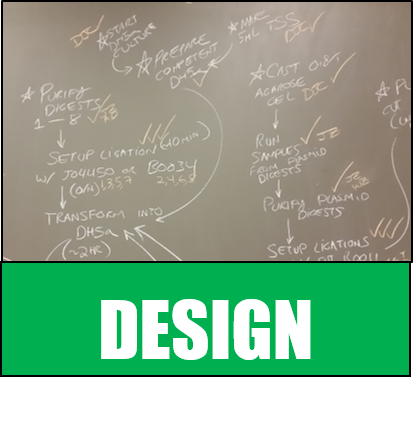Djcamenares (Talk | contribs) (→DNA Design) |
Djcamenares (Talk | contribs) (→DNA Design) |
||
| Line 45: | Line 45: | ||
| − | DNA was designed from K. stuttgarteinsis protein sequences corresponding to the gamma, beta, and alpha subunits of Hydrazine Synthase (GenBank accessions CAJ73611.1 [https://www.ncbi.nlm.nih.gov/protein/91200562] | + | DNA was designed from K. stuttgarteinsis protein sequences corresponding to the gamma, beta, and alpha subunits of Hydrazine Synthase (GenBank accessions CAJ73611.1[https://www.ncbi.nlm.nih.gov/protein/91200562] CAJ73612.1[https://www.ncbi.nlm.nih.gov/protein/91200563] and CAJ73613.1[https://www.ncbi.nlm.nih.gov/protein/91200564], respectively). This DNA was reverse translated first using the Sequence Manipulation Suite[http://www.bioinformatics.org/sms2/], and ultimately using software developed by our team. |
The program we developed takes FASTA formatted protein sequence(s) in a single file and reverse translates them to DNA, using codons preferred by E. coli. Furthermore, the program will eliminate any of the standard BioBrick restriction sites from the DNA sequence (i.e. EcoRI, XbaI, SpeI, and PstI), while preserving the encoded information. Finally, the sequence will be changed (again, while preserving the encoded information) so as to eliminate any repetitive blocks of 8 nucleotides; that is, any pattern of 8 nucleotides that occurs more than once in the sequence. This last step is performed to satisfy a requirement imposed by IDT during synthesis. | The program we developed takes FASTA formatted protein sequence(s) in a single file and reverse translates them to DNA, using codons preferred by E. coli. Furthermore, the program will eliminate any of the standard BioBrick restriction sites from the DNA sequence (i.e. EcoRI, XbaI, SpeI, and PstI), while preserving the encoded information. Finally, the sequence will be changed (again, while preserving the encoded information) so as to eliminate any repetitive blocks of 8 nucleotides; that is, any pattern of 8 nucleotides that occurs more than once in the sequence. This last step is performed to satisfy a requirement imposed by IDT during synthesis. | ||
Revision as of 19:06, 4 November 2016
DNA Design
DNA was designed from K. stuttgarteinsis protein sequences corresponding to the gamma, beta, and alpha subunits of Hydrazine Synthase (GenBank accessions CAJ73611.1[1] CAJ73612.1[2] and CAJ73613.1[3], respectively). This DNA was reverse translated first using the Sequence Manipulation Suite[http://www.bioinformatics.org/sms2/], and ultimately using software developed by our team.
The program we developed takes FASTA formatted protein sequence(s) in a single file and reverse translates them to DNA, using codons preferred by E. coli. Furthermore, the program will eliminate any of the standard BioBrick restriction sites from the DNA sequence (i.e. EcoRI, XbaI, SpeI, and PstI), while preserving the encoded information. Finally, the sequence will be changed (again, while preserving the encoded information) so as to eliminate any repetitive blocks of 8 nucleotides; that is, any pattern of 8 nucleotides that occurs more than once in the sequence. This last step is performed to satisfy a requirement imposed by IDT during synthesis.
The program, protein2bioBrick, is freely available in this zip package, that includes a stand-alone executable JAR file, the source code, and some example data. Your computer must have some Java package already installed in order to use the program.
Restriction Enzyme Cloning
text
Gibson Assembly
text


